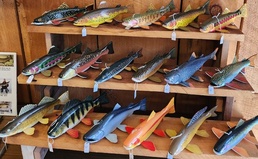
50 Years Since the Sinking of the Edmund Fitzgerald
Bestselling author John U. Bacon and his new book on the Great Lakes shipping disaster
By Ren Brabenec | Nov. 1, 2025
Gordon Lightfoot’s “The Wreck of the Edmund Fitzgerald” helped the world immortalize the shipwreck on Lake Superior. Now, Michigan resident and New York Times bestselling author John U. Bacon has contributed his own work to the living history of the ship with his latest gripping read, The Gales of November: The Untold Story of the Edmund Fitzgerald.
Nov. 10 marks the 50th anniversary of the sinking of the Edmund Fitzgerald, and Bacon will visit the National Writers Series Nov. 6 to discuss the new book. Ahead of the event, we sat down with Bacon to learn why telling the story of the shipwreck is so important, even half a century later.
A New Look at an Old Mystery
As is the case for many Michiganders, the wreck of the Edmund Fitzgerald has been both terrifying and fascinating for author John Bacon. “I was 11 years old when the ship went down,” Bacon says. “I still remember it and the haunting feeling it gave me whenever I looked out across any of the Great Lakes.”
Bacon has authored 14 books on sports, business, and history, but he says he’s always wanted to tell people about the dual wonder and danger of Michigan’s lakes, the importance of humanizing the people who’ve died on commercial shipping vessels, and the significance of Great Lakes shipping.
“Fortunately, the families of the [Edmund Fitzgerald] sailors were willing to talk with me about their fathers, their uncles, their brothers, cousins, and in a couple cases their boyfriends,” Bacon says. “They’ve never told their stories publicly before, so I’m greatly appreciative. I think the readers will be, too.”
Not only does the book have these brand-new perspectives, but it also takes a different approach to the mystery of the ship’s sinking.
“Take what actually caused the shipwreck,” Bacon says. “Authors have devoted entire books to push their theories that the Fitzgerald sank due to this or that reason. My book does not attempt to solve the mystery of the ultimate causes of the Fitzgerald’s demise—my belief is that there were probably many [causes].”
He continues, “Some of the possible causes include: the design of the ship itself, a modular construction which favored welds over rivets, which made it more flexible than most; the government’s decision to relax regulations on how much cargo a ship can carry; the storm of the century, which was only partially forecast and insufficiently communicated to the captains; mechanical failures on the Fitzgerald and the Whitefish Point’s lighthouse; a couple well-intended decisions by Captain McSorley to play it safe, which might have backfired; and finally the possibility that the Fitzgerald sailed over Six Fathom Shoal. A fathom is six feet, so six fathoms is 36 feet, but in some places it’s only 11.”
How One Shipwreck Changed Great Lakes Shipping
One of the many fascinating aspects of the Edmund Fitzgerald story is that, despite thousands of shipwrecks occurring on the Great Lakes before the Fitzgerald sank in 1975, not one such wreck has occurred since.
“Because the Fitzgerald’s sinking drew so much attention, [people who worked in the industry] greatly improved forecasting, communications with the captains, and decision making from corporate headquarters to the pilothouse,” explains Bacon.
“[Those efforts] produced this stunning statistic,” Bacon continued. “From 1875 to 1975, the Great Lakes claimed at least 6,000 commercial shipwrecks, but in the half century since the Edmund Fitzgerald went under, not one commercial ship has sunk on the Great Lakes, by far the longest run of safe trips since the French fur traders started traversing the same waters four hundred years ago. As one of my experts said, ‘When do you fix anything? When it’s broken.’”
That statistic is something to celebrate, but it required the lives of 29 men to finally prompt the shipping industry to implement better safety protocols and prioritize the lives of sailors and their families over profits.
“When talking with the families of the victims, you notice how often they make that very point,” Bacon said. “As devastating as it was to lose their fathers, their uncles, their brothers, their cousins, and their boyfriends, they are acutely aware that no commercial ships have suffered a similar fate since, and they justly take pride in that fact. The immeasurable sacrifices of that day were not made in vain.”
An Essential Industry
The Bay Mills News, a monthly paper published by the Bay Mills Indian Community in the eastern Upper Peninsula, has recently been reporting extensively on the critical nature of Great Lakes shipping and the ongoing $2.6 billion New Lock at the Soo infrastructure project made possible by President Joe Biden’s 2021 Bipartisan Infrastructure Law. That project aims to provide resiliency and expand U.S. shipping capacity in an increasingly competitive global shipping industry.
According to the reporting, Great Lakes shipping is so essential to U.S. manufacturing and national security that a six-month slowdown of ship movement across the Great Lakes and through the Soo Locks would reduce U.S. GDP by $1.1 trillion and result in the loss of 11 million jobs.
To Bacon, it was a big goal for the book to use the story of the Edmund Fitzgerald to emphasize the importance of modern Great Lakes shipping and the sailors who make it possible.
“The Great Lakes are bigger and more dangerous than most people realize,” Bacon says. “And Great Lakes shipping is far more important than we know. We depend on these sailors more than we think, if we think about them at all; and because the Fitzgerald’s last trip is more complicated than it appears at first, we’ll probably never know exactly what happened. Bruce Hudson’s mom Ruth said it best: ‘Only 30 know what happened: 29 men and God.’ And they’re not talking, so we’re just guessing.”
About the Event
An Evening with John U. Bacon will take place at 7pm on Thursday, Nov. 6, at City Opera House and will include a Q&A and an author book signing. Tickets are $32 for Tier One, $21 for Tier Two, and $16 for students and educators. For those who cannot attend the event in person, a live virtual option is available, as well as an on-demand streaming option. For in-person tickets, head to cityoperahouse.org. Visit nationalwritersseries.org to order virtual tickets or purchase the book.
Trending

The Art of the Decoy
On mantles and shelves around the country (and indeed, around the world) sit intricate and beautiful wooden fish decoys that… Read More >>
Wreath the Halls
Get ready for the holidays with the ultimate wreath workshop! Boyne Mountain hosts Wreathfest, Saturday, Nov. 8, with Kalin … Read More >>
Saving Wild Elk Country
This fall, the elk population got a helping hand from their human friends. Gaylord-based conservation nonprofit Huron Pines … Read More >>


